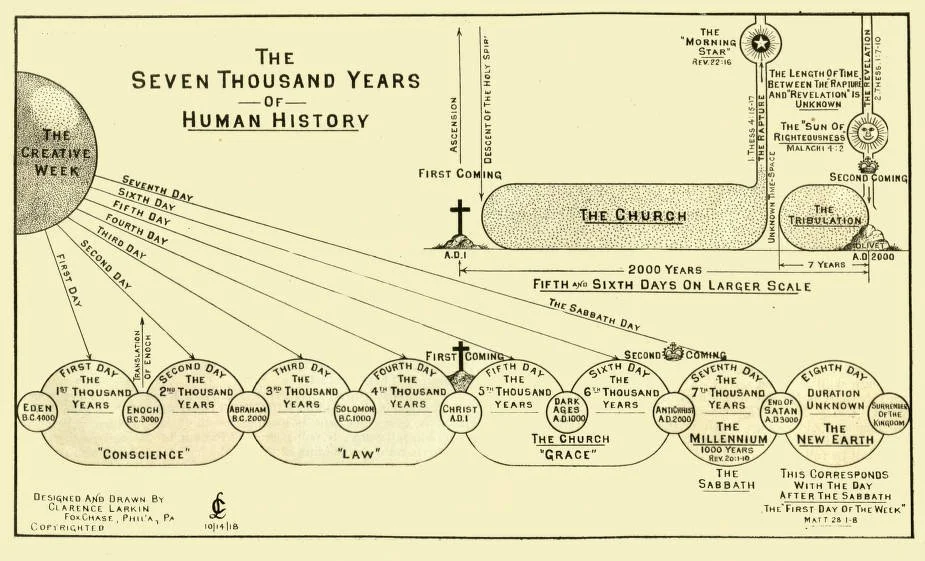Dispensationalism, Its History & Framework (Part 1)
Dispensationalism arose within the last 150 years; it is a system of interpretation for reading and understanding the Bible. Central to its uniqueness is its separation of Israel and the church: that God has a different plan for salvation for ethnic Israel (the Jewish people) and the Christian church.
This summer during Pastor Nate Walker’s sabbatical, Pastor Matt Boffey and I preached through the books of 1 and 2 Thessalonians. In these books, the Apostle Paul wrote to the Thessalonian Christians to calm their anxiety and provide instructions on how they might live. It is clear from the texts that much of the anxiety the Thessalonians struggled with was due to false teaching around the Second Coming of Christ. In response, Paul in his letter provided some teaching regarding the Day of the Lord and a number of other important events concerning the “last things.”
It is remarkable that, much like the Thessalonians, Christians today struggle with anxiety around the “end times” and what the Second Coming of Christ might look like. And like the Thessalonians, many evangelical Christians have been confused by bad teaching about eschatology (the doctrines of last things), particularly in the form of something called dispensationalism. Over the course of the series through 1 and 2 Thessalonians, this subject of dispensationalism came up, and we thought further teaching on eschatology would be helpful.
What is Dispensationalism? (An Overview)
Dispensationalism arose within the last 150 years; it is a system of interpretation for reading and understanding the Bible. It is distinct from, and incompatible with, the covenant theology held by our Reformed tradition and other Christians over the past 2,000 years of church history. A key aspect of dispensationalism is its unique views regarding the end-times events laid out in the Bible. Yet, more central to its uniqueness is its separation of Israel and the church. While covenant theology holds to the historic view that the Old Testament people of Israel and the Church are one covenant people in God’s redemptive plan throughout history, dispensationalism introduces a unique view: that God has a different plan for salvation for ethnic Israel (the Jewish people) and the Christian church.
History of Dispensationalism
The dispensational system of biblical interpretation first crystalized in the mid-1800s due to the ministry of John Nelson Darby with the Plymouth Brethren in Great Britain and Ireland. One of the emphases of the Plymouth Brethren movement was their anticipation for Christ to return at any time (and likely within their generation). In addition to their novel prophetic views, they were enamored by charismatic signs and gifts, such as speaking in tongues and prophetic utterances. Darby stressed the two distinct peoples of God: Israel and the Church—a sharp division between the Old and New Testaments in how God dealt with those peoples—and he adopted a futuristic understanding of Revelation, in which God would remove the church from the world and finish his prophetic promises to the people of Israel. Darby and the Plymouth Brethren believed that would occur very soon.
The idea of a “rapture” developed from the combination of this new distinction between Israel and the Church, end-times fervor, and ecstatic revivalism. Out of these, dispensationalists developed the idea that in this rapture (which would occur before the coming tribulation), God would remove the church from the world before their futuristic understanding of the events described in Revelation would occur. The first known articulation of a “pre-trib rapture” came from fifteen-year-old Margaret MacDonald in the form of an ecstatic prophetic utterance at a prayer meeting in her brother’s home in western Scotland, 1830 (MacPherson). Darby further popularized this view among the Plymouth Brethren and exported it from Great Britain to America. In America, Cyrus Scofield popularized these doctrines with his immensely popular Scofield Reference Bible, which was one of the first study Bibles, and contained dispensational commentary throughout the text of Scripture. The Scofield Reference Bible’s pessimistic views towards the history of the Church in the world, and the timing of its publication on the eve of World War I, cemented the idea into the evangelical psyche that the world was getting progressively more evil and would continue in that way until the Antichrist would arise after the Church was raptured out of the world.
As the year 2000 approached, rapture fever increased and was fueled by the fictional Left Behind franchise of books and movies by Tim LaHaye and Jerry B. Jenkins, which presented dispensational end-times views in story form.
During the Cold War, in the 1960s through the 1980s, dispensationalism went mainstream into the wider culture with the publication of Hal Lindsey’s book The Late Great Planet Earth and Edgar Whisenant’s book 88 Reasons Why the Rapture Will Be in 1988. As dispensationalism matured in the 20th century, confidence was stirred in its views when the modern nation of Israel was birthed in 1948, and when it miraculously won the Six-Day War in 1967 against a coalition of Arab states. In light of these historical developments, many dispensational teachers and groups continued the trend from 19th-century religious movements to believe that the current generation was the last generation before Christ’s return. Many dispensational ministers (e.g. Edgar Whisenant, Harold Camping, Chuck Smith, and others) would set specific dates or a range of years for Christ’s expected return. As the year 2000 approached, rapture fever increased and was fueled by the fictional Left Behind franchise of books and movies by Tim LaHaye and Jerry B. Jenkins, which presented dispensational end-times views in story form.
Towards the end of the 20th century and into the 21st century, dispensationalism began to fall out of favor in academia as its novel views were critiqued by other conservative biblical scholars who held to traditional covenant theology, but dispensationalism remained quite popular with the evangelical laity (Admin). The sad fact about dispensationalism being so popular—in particular among American evangelicals—is that, while it has been marketed as biblical, and as a “literal” way of reading the Bible, it leads to significant interpretive difficulties in Scripture, which lead to problems in the personal lives of Christians as well as broader problems in how Christians interact with the world.
What Does Dispensationalism Actually Teach?
Our church stands within the historic Reformed tradition and holds to covenant theology, which can be summarized as God having one people throughout all of redemptive history that was known as “Israel” prior to Christ’s Incarnation, and as the “Church” after his Ascension. Dispensationalism (as seen in the chart above) has a much more complicated view. While I hold to Covenant theology, I am intimately familiar with dispensationalism, as I grew up in a church that held to that view.
In the dispensational view, God deals with humanity differently in each dispensation or “age” of human history. This typically starts with the time of Innocence before the Fall, followed by a time of Conscience until the Flood. This is followed by the rule of human governments until the Tower of Babel, the time of the Patriarchs from Abraham to Moses, and then the time of the Mosaic Law from David to Christ. The dispensationalists see specific promises to the ethnic people of Israel from the time of Abraham until the first coming of Christ.
Dispensationalists believe that the Jews’ official rejection of Jesus Christ was a significant moment in history that essentially stopped the “prophetic clock” in Scripture. They teach that the prophetic promises in Daniel, Matthew 24-25, and Revelation are now on hold during the dispensation or “age” of the Church, which has lasted 2,000 years (from Pentecost to today). According to dispensationalism, the Church exists in a parenthesis in prophetic history, as they believe the prophetic promises described in the Bible are for the people of Israel, and that the “true” Church will be raptured before the prophetic events described by Daniel, Jesus, and the Apostle John are destined to occur (during the Tribulation, and before the Millennium, when according to dispensationalists, Christ will finally rule as the Messianic King on Earth).
What Is The Rapture?
Dispensationalists teach a doctrine of a secret “rapture” during which, at some unknown time (but likely in the near future), millions of Christians will disappear off the face of the Earth without warning as Christ returns to “meet them in the air” shortly before the Antichrist will take power over the Earth and God’s judgment on the nations of the Earth will occur. They build this idea from 1 Thessalonians 4:13-18 and 1 Corinthians 15:51-52, which the Church has historically understood to refer to the Second Coming of Christ. In light of these passages, dispensationalists will interpret Matthew 24:37-41 to say that the righteous will be taken away in a sudden manner at the Son of Man’s return.
Not only has dispensationalism induced fear in the lives of Christians, but its many failed predictions of Christ’s imminent return has stained the reputation of Christians amongst unbelievers.
This is an inverse reading of the passage, as it has been historically understood that the wicked are taken away, as the wicked were swept away in the days of Noah during the Flood. Not one of these passages was ever understood to refer to any “secret rapture” until the 15-year-old Margaret MacDonald had her “prophetic vision” of this idea in 1830. Until that time, the consistent teaching of the Church regarding these passages was that the Second Coming of Christ will be a singular event, and not a two-part event.
What is the Tribulation?
The Tribulation refers to a seven-year period of time during which the prophetic judgments described in the books of Daniel, Ezekiel, and Revelation are to occur. Dispensationalists interpret these prophecies in a futuristic manner, as they believe they will not take place until after the rapture takes place.
What is the Millennium?
Dispensationalists believe that after these seven years, Christ will return in glory, and that he will usher in his Messianic earthly kingdom which will last for 1,000 years. This is taken from Revelation 20, and is known as the Millennium. As Dispensationalists hold to Christ’s Second Coming occurring before the Millennium, they hold to a Premillennial view of Christ’s return. Due to the dispensational ideas of a secret rapture, this is a distinct view from Historic Premillennialism, which believes that the Second Coming is a singular event at the culmination of history.
Why is it Important to Understand What Dispensationalism Teaches?
Right doctrine matters, and this includes right doctrine concerning Christ’s Return and the Last Things. Eschatology is not an area of theology to be ignored, as the views Christians hold concerning the end of history have a direct bearing on their daily lives, both as individuals, and corporately in how we interact with the world. These realities are true of dispensationalism, and its rise in popularity amongst American Evangelicals in the 20th century had a huge impact on both Christian and secular culture, international politics, and even the environment, as these doctrinal views played out in the lives of Christians.
In addition to the large cultural impact of dispensationalism, the same anxiety that plagued the Thessalonian church in their confusion around the Second Coming of Christ has plagued Christians as they’ve wrestled with the apocalyptic fervor of the past 150 years. Not only has dispensationalism induced fear in the lives of Christians, but its many failed predictions of Christ’s imminent return has stained the reputation of Christians amongst unbelievers.
While this article was a primer on dispensationalism, my next article will provide a thorough Biblical and historical critique of dispensational views, and in another article I will further discuss the dangerous impact that dispensationalism has had in Christian culture and the broader world.
End Notes:
Admin, C. (2017, May 31). Only one-third of pastors share “Left behind” end times theology. Christianity Today. https://www.christianitytoday.com/2016/04/sorry-left-behind-pastors-end-times-rapture-antichrist/
Dave MacPherson, The Incredible Cover-Up (Medford, OR: Omega Publications, 1980).



